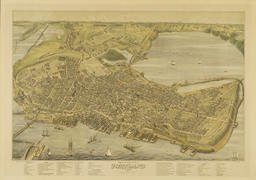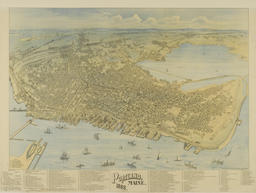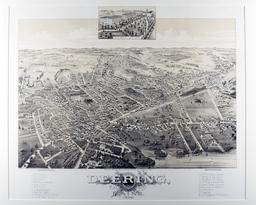
The Portland peninsula was represented twice in the bird's eye views that were so popular in the United States after the Civil War. These bird's eye views provide historians with invaluable visual records for reconstructing an accurate representation of a particular place in time.
The 1876 view [81], with its finely rendered architectural and topographic detail, was published by the Stoner Company of Madison Wisconsin, a prolific producer of such panoramic views. After the Great Fire of 1866, the city's resurgence was reflected in its rapid population growth increasing to about 31,500 residents in 1870. This demographic growth is reflected in the increased residential development on Munjoy Hill and the West End.
Joseph Warner
Bird’s Eye View of the City of Portland, Maine
Madison, Wisconsin: J. J. Stoner, 1876
Charles Shober & Co. Prop’s Chicago Lithography Co.
Lithograph, 61.5 x 87 cm
Private Collection
A second edition of this bird's eye view [82], produced in 1888, is considered rarer because it was printed on pulp paper which is prone to disintegrate. Consequently many copies have deteriorated over time. During this decade, the city's population increased to some 33,000 residents on the peninsula. This view includes the new Union Station at the upper left, built of granite on St. John Street in 1888 by the Maine Central Railroad and demolished in 1961.
George H. Walker and Co.
Portland, Maine 1888
Portland: Skillings and Howard, 1888
Lithograph, 68 x 89 cm
Private Collection
Deering, which separated from Westbrook, was established as a town in 1871. Fifteen years after incorporation in 1886, this bird's eye view [83] was published. By this time its population had grown to over four thousand residents. Ties to Portland from outlying suburban districts increased with the construction of a horse railway in 1863. The development of these early commuter communities accelerated when the electric trolley line replaced the horse railway in 1895. Four years later Deering, which had become a city in 1892, was annexed by Portland.
Deering, Cumberland County, Maine
Brockton, Mass: A. F. Poole and Co., 1886
Heliotype Printing Company, Boston
Heliotype, 54 x 60 cm
Private Collection




